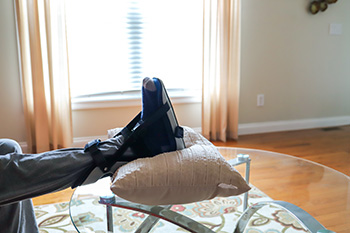
Ankle pain while cycling is often due to poor form, overtraining, or using a bike that is the wrong size. Improper cycling form, such as incorrect foot positioning on the pedals, can strain the ankle joints and muscles. Starting with intense or prolonged rides too quickly without allowing your body to adapt can also lead to overuse injuries, including ankle pain. Additionally, riding a bike that does not fit your body properly can force your ankles into awkward positions, causing discomfort and potential injury. To prevent ankle pain, focus on maintaining correct form by keeping your feet properly aligned on the pedals. Gradually increase the intensity and duration of your rides to build strength and endurance. Additionally, ensuring your bike is properly fitted to your body can also help maintain proper alignment and reduce the risk of ankle pain. If your ankle begins to hurt during or after a bike ride, it is suggested that you consult a podiatrist who can properly treat it, and guide you on additional ankle injury prevention techniques.
Sports related foot and ankle injuries require proper treatment before players can go back to their regular routines. For more information, contact one of our podiatrists of Jill Einhorn, DPM and James Einhorn, DPM. Our doctors can provide the care you need to keep you pain-free and on your feet.
Sports Related Foot and Ankle Injuries
Foot and ankle injuries are a common occurrence when it comes to athletes of any sport. While many athletes dismiss the initial aches and pains, the truth is that ignoring potential foot and ankle injuries can lead to serious problems. As athletes continue to place pressure and strain the area further, a mild injury can turn into something as serious as a rupture and may lead to a permanent disability. There are many factors that contribute to sports related foot and ankle injuries, which include failure to warm up properly, not providing support or wearing bad footwear. Common injuries and conditions athletes face, including:
Sports related injuries are commonly treated using the RICE method. This includes rest, applying ice to the injured area, compression and elevating the ankle. More serious sprains and injuries may require surgery, which could include arthroscopic and reconstructive surgery. Rehabilitation and therapy may also be required in order to get any recovering athlete to become fully functional again. Any unusual aches and pains an athlete sustains must be evaluated by a licensed, reputable medical professional.
If you have any questions please feel free to contact our offices located in Brooklyn and Astoria, NY . We offer the newest diagnostic and treatment technologies for all your foot and ankle needs.

Ankle bursitis occurs when the bursae sacs in the ankle become inflamed, causing significant discomfort and mobility issues. Bursae are small, fluid-filled sacs that act as cushions between bones, tendons, and muscles, reducing friction and facilitating smooth joint movement. These sacs can become irritated or inflamed, typically due to overuse, trauma, infection, or medical conditions like gout or rheumatoid arthritis. Common symptoms of ankle bursitis include pain and tenderness in the ankle, swelling, stiffness, warmth, or redness around the affected area. Aching or throbbing pain also can occur, especially when pressure is applied. Overuse from activities like running or dancing, trauma from injuries, or wearing poorly fitting shoes are frequent causes. Proper diagnosis may include imaging tests like X-rays or MRIs to rule out other conditions. In some cases, fluid from the bursae might be tested for infections. If you're experiencing symptoms of ankle bursitis, it is suggested that you make an appointment with a podiatrist for a diagnosis and treatment.
Ankle pain can have many different causes and the pain may potentially be serious. If you have ankle pain, consult with one of our podiatrists from Jill Einhorn, DPM and James Einhorn, DPM. Our doctors will assess your condition and provide you with quality foot and ankle treatment.
Ankle pain is any condition that causes pain in the ankle. Due to the fact that the ankle consists of tendons, muscles, bones, and ligaments, ankle pain can come from a number of different conditions.
Causes
The most common causes of ankle pain include:
Symptoms
Symptoms of ankle injury vary based upon the condition. Pain may include general pain and discomfort, swelling, aching, redness, bruising, burning or stabbing sensations, and/or loss of sensation.
Diagnosis
Due to the wide variety of potential causes of ankle pain, podiatrists will utilize a number of different methods to properly diagnose ankle pain. This can include asking for personal and family medical histories and of any recent injuries. Further diagnosis may include sensation tests, a physical examination, and potentially x-rays or other imaging tests.
Treatment
Just as the range of causes varies widely, so do treatments. Some more common treatments are rest, ice packs, keeping pressure off the foot, orthotics and braces, medication for inflammation and pain, and surgery.
If you have any questions, please feel free to contact our offices located in Brooklyn and Astoria, NY . We offer the newest diagnostic and treatment technologies for all your foot care needs.
 An ankle-foot orthosis, or AFO, is a brace designed to support the ankle and foot, improving stability and alignment. It works by restricting movement in specific directions, thereby aiding in mobility and reducing the risk of injury. AFOs are commonly prescribed for individuals with conditions such as cerebral palsy, stroke, multiple sclerosis, or severe ankle arthritis. They are also used for drop foot, where the individual has difficulty lifting the front part of the foot. Diagnosing the need for an AFO involves a thorough examination by a podiatrist, including medical history, physical assessment, and sometimes imaging studies to understand the underlying condition and its severity. There are various types of AFOs, including rigid AFOs for maximum support, articulated AFOs allowing controlled movement, and dynamic AFOs designed for more natural movement. If you suffer from ankle pain, it is suggested that you schedule an appointment with a podiatrist for a diagnosis and treatment. If an AFO will help you, this foot doctor can provide personalized advice and a proper fitting.
An ankle-foot orthosis, or AFO, is a brace designed to support the ankle and foot, improving stability and alignment. It works by restricting movement in specific directions, thereby aiding in mobility and reducing the risk of injury. AFOs are commonly prescribed for individuals with conditions such as cerebral palsy, stroke, multiple sclerosis, or severe ankle arthritis. They are also used for drop foot, where the individual has difficulty lifting the front part of the foot. Diagnosing the need for an AFO involves a thorough examination by a podiatrist, including medical history, physical assessment, and sometimes imaging studies to understand the underlying condition and its severity. There are various types of AFOs, including rigid AFOs for maximum support, articulated AFOs allowing controlled movement, and dynamic AFOs designed for more natural movement. If you suffer from ankle pain, it is suggested that you schedule an appointment with a podiatrist for a diagnosis and treatment. If an AFO will help you, this foot doctor can provide personalized advice and a proper fitting.
If you are having discomfort in your feet and would like to try orthotics, contact one of our podiatrists from Jill Einhorn, DPM and James Einhorn, DPM. Our doctors can provide the care you need to keep you pain-free and on your feet.
What Are Orthotics?
Orthotics are inserts you can place into your shoes to help with a variety of foot problems such as flat feet or foot pain. Orthotics provide relief and comfort for minor foot and heel pain but can’t correct serious biomechanical problems in your feet.
Over-the-Counter Inserts
Orthotics come in a wide variety of over-the-counter inserts that are used to treat foot pain, heel pain, and minor problems. For example, arch supports can be inserted into your shoes to help correct overarched or flat feet, while gel insoles are often used because they provide comfort and relief from foot and heel pain by alleviating pressure.
Prescription Orthotics
If over-the-counter inserts don’t work for you or if you have a more severe foot concern, it is possible to have your podiatrist prescribe custom orthotics. These high-quality inserts are designed to treat problems such as abnormal motion, plantar fasciitis, and severe forms of heel pain. They can even be used to help patients suffering from diabetes by treating foot ulcers and painful calluses and are usually molded to your feet individually, which allows them to provide full support and comfort.
If you are experiencing minor to severe foot or heel pain, it’s recommended to speak with your podiatrist about the possibilities of using orthotics. A podiatrist can determine which type of orthotic is right for you and allow you to take the first steps towards being pain-free.
If you have any questions please contact our offices located in Brooklyn and Astoria, NY . We offer the newest diagnostic and treatment technologies for all your foot and ankle needs.

Plantar fibromas are benign growths that develop in the arch of the foot, often causing discomfort and difficulty with walking. When conservative treatments fail to provide relief, foot surgery may be necessary to alleviate symptoms and restore mobility. During the procedure, the patient is typically placed under local anesthesia, numbing the foot to minimize pain. The surgeon then makes an incision in the skin, carefully dissecting the fibroma from surrounding tissues and nerves. Once the fibroma is removed, the incision is closed with sutures, and a dressing is applied to promote healing. Recovery time varies, depending on the size of the fibroma and the individual's ability to heal, but most patients can expect to resume normal activities within a few weeks. While surgical plantar fibroma excision offers a permanent solution, it is essential to discuss the risks and benefits with a podiatrist. If you have a plantar fibroma that is causing you pain, it is suggested that you make an appointment with a podiatrist who can determine if this surgery is right for you.
Foot surgery is sometimes necessary to treat a foot ailment. To learn more, contact one of our podiatrists of Jill Einhorn, DPM and James Einhorn, DPM. Our doctors will assist you with all of your foot and ankle needs.
When Is Surgery Necessary?
Foot and ankle surgery is generally reserved for cases in which less invasive, conservative procedures have failed to alleviate the problem. Some of the cases in which surgery may be necessary include:
What Types of Surgery Are There?
The type of surgery you receive will depend on the nature of the problem you have. Some of the possible surgeries include:
Benefits of Surgery
Although surgery is usually a last resort, it can provide more complete pain relief compared to non-surgical methods and may allow you to finally resume full activity.
Surgical techniques have also become increasingly sophisticated. Techniques like endoscopic surgery allow for smaller incisions and faster recovery times.
If you have any questions please feel free to contact our offices located in Brooklyn and Astoria, NY . We offer the newest diagnostic and treatment technologies for all your foot and ankle needs.